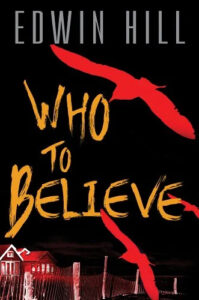What really happened?
That question lies at the heart of so many crime novels, and yet the answer, that very truth, can often depend on who’s telling the story and the truth they believe. Authors employ various story structures to dole out information in a way that keeps the questions coming and the answers satisfying. When those truths don’t quite mesh, conflict and tension ensue.
I love stories that play with perspective, and how different people interpret the same events, so that question—what really happened?—lies at the heart of my latest novel, Who to Believe. The story takes place over the course of a single night, as a group of friends gather in the wake of a brutal murder in a small town. Each of the friends has their own take on who might have committed the crime, and, in turn, we learn how each character interprets the story for themselves. We also learn their secrets—and they have plenty of them.
For this novel, I was inspired by the Akira Kurosawa film Rashomon, which lends its name to this style of storytelling (and itself is inspired by two short stories by Ryūnosuke Akutagawa), as well as the TV show The Affair, all of which look at how stories unfold through the lens of multiple perspectives. But there are lots of fun ways to use structure to explore stories in new and reinvented ways and to answer that central question, what really happened? Here are some of my favorites.
Everyone’s a suspect.
They All Fall Down by Rachel Howzell Hall and Nine Lives by Peter Swanson
It’s hard to write about structure without bringing Agatha Christie into the mix, especially her structural tour-de-force, And Then There Were None, the story of ten strangers packed off to a stormy island where they meet their maker one by one. The fun part of Christie’s novel was that instead of writing a traditional investigator—say Hercule Poirot or Jane Marple—the reader plays the investigator, piecing together the various threads in the plot so that in the end only the reader knows the whole truth.
Several authors have given this structure their own spin over the years. Two that I thought improved on the source material were Hall with They All Fall Down, which moves the story to an island off the coast of Mexico and injects it with a dose of southern California reality television, and Swanson with Nine Lives, which manages to take the story national as the killer hunts down victims in locations all over the United States.
The novel within the novel.
Magpie Murders by Anthony Horowitz
It’s hard to beat the fun of a story-within-a-story like Horowitz tackles with this novel. Here, we begin with a very meta prologue by an unnamed editor reading the manuscript for a golden age style mystery called Magpie Murders. The manuscript touches on plenty of the genre’s tropes, including a brilliant detective with a less-than-brilliant sidekick, a country manor house, a locked room murder, and quintessentially English place names like Pye Hall and, in particular, Dingle Dell, among others. The less that is said about how the prologue relates to the overall story, the better, but the structure of the story-within-the story proves to be essential to understanding the novel and solving the murder.
Playing with time.
Wrong Place Wrong Time by Gillian McAllister
One of my favorite plays is called Betrayal by Harold Pinter. It begins with the end of an affair, and then moves backwards in time so that the final scene in the play takes place when the affair begins.
McAllister takes a similar approach to Wrong Place Wrong Time, which begins with our protagonist, Jen, witnessing her 18-year-old son stabbing someone, a crime that results in his arrest. The next time Jen wakes, though, it’s a day earlier instead of a day later and as the novel progresses, Jen goes further and further back in time as she tries to stop the crime from happening in the first place. Like with Pinter’s play, this structure allows the reader to view events through the lens of the future, casting shadows of what’s to come over every action and choice.
The Rashomon.
An Instance of the Fingerpost by Iain Pears
Like my novel, Who to Believe, Pears’ An Instance of the Fingerprints is a classic Roshamon, telling the same story, the murder of Robert Grove, and the subsequent trial and execution of another character, though different lenses – but talk about ambitious! Set in 17th Century Oxford, Pears uses four separate first-person accounts, a Venetian visiting Oxford, a lawyer, a priest and mathematician, and a scholar, then leaves the reader to piece together the final truth in an immensely satisfying conclusion.
The 7 1/2 Deaths of Evelyn Hardcastle by Stuart Turton
Turton’s novel takes us back to Christie territory, as guests descend on a manor house in the English countryside for a masquerade ball. And like with a good Christie novel, a murder gets the plot started. What sets this novel apart is that the protagonist then inhabits eight different characters as the mystery of Evelyn Hardcastle’s death (and one other) slowly unfolds in turn through each of their perspectives.
The midpoint reversal.
I Let You Go by Claire Mackintosh
Sometimes the best structural tricks are to stick to the tried and true, and to depend on your midpoint to provide the shock value of a perfect reversal. Think of Dorothy in the Wizard of Oz, who spends the first half of the story on a journey to the Emeral City, only to learn that her story isn’t really about finding the Wizard, but something much more complex. Many might point to Gillian Fynn’s Gone Girl as a perfect midpoint reversal, too, as that novel becomes something completely different once a major reveal comes to light.
At first, Mackintosh’s novel, I Let You Go, seems to be about the search for a missing woman, one who fled to a remote seaside village after the death of the son. The story follows Jenna Grey as she tries to rebuild her life, and the two police inspectors trying to locate her. A perfectly set up secret revealed at the end the novel’s Part One sets up and entirely different story for Part 2, and provides the reader with the kind of reversal novelists dream of concocting.
***


















